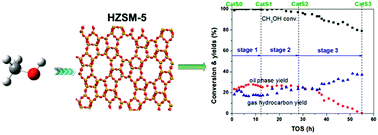The catalytic properties evolution of HZSM-5 in the conversion of methanol to gasoline
Abstract
Liquid hydrocarbons could be produced by the direct conversion of methanol. However, the normally used zeolite catalysts cannot maintain a long lifetime. As the conversion of methanol to gasoline (MTG) over HZSM-5 progresses, it is observed that the ethylene yield increases sharply at the time on stream (TOS) of 12 h, then dimethyl ether starts to form at 28 h, and finally the oil phase disappears after 55 h along with the decrease of methanol conversion. The changes of catalytic activity and corresponding product selectivities were recorded. Several characterization methods, such as N2 adsorption, XRD, NMR, TG, NH3-TPD and pyridine FTIR, were performed for the fresh and spent catalysts at the above-mentioned three TOS. The crystallinity of HZSM-5 decreased gradually with the extension of TOS caused by the defection of the framework through dealumination of the catalysts. Although the number of Brønsted acid sites decreased sharply, only slight BET surface area decrease and coke formation occurred in the initial reaction stage. With the extension of TOS, more and more heavy aromatics were formed and adsorbed on the acid sites, leading to the decrease of active hydrocarbon pool species and severe carbon deposition on the catalyst. As a result, the significant deactivation of the catalyst occurred and finally no oil phase can be collected.


 Please wait while we load your content...
Please wait while we load your content...